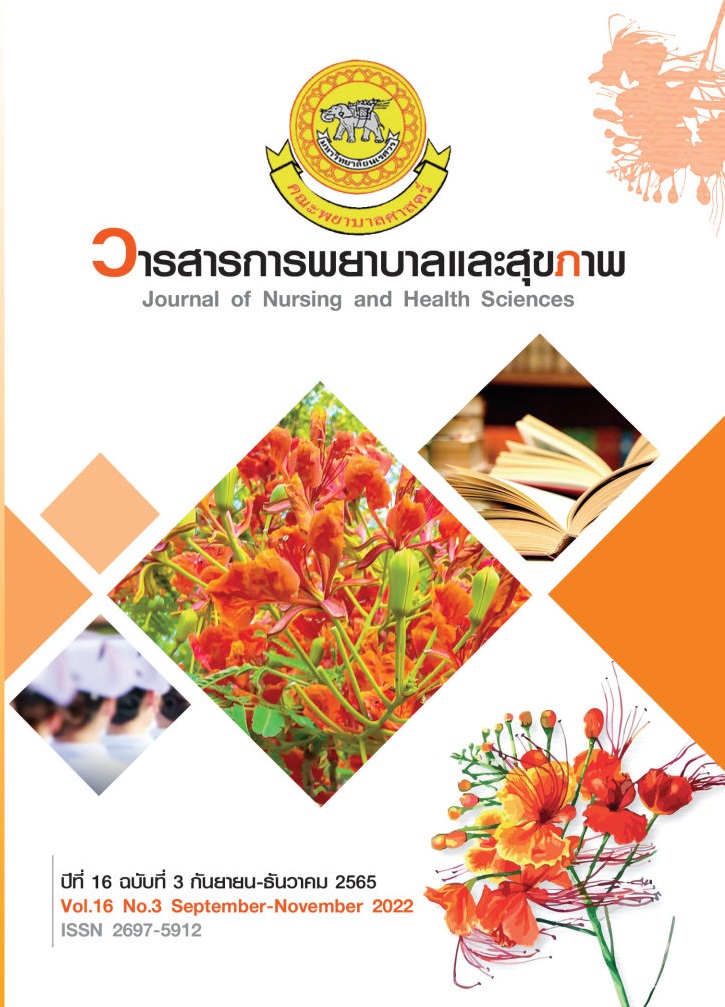อิทธิพลของอาการไม่พึ่งประสงค์ที่มีผลต่อภาวะการทำหน้าที่ของ ผู้ป่วยมะเร็งระยะลุกลามที่ได้รับยาเคมีบำบัด
Main Article Content
บทคัดย่อ
โรคมะเร็งเป็นปัญหาสุขภาพที่สำคัญของประเทศไทยและมีความรุนแรงของโรคเพิ่มขึ้น โดยเฉพาะผู้ป่วยมะเร็งระยะลุกลามการรักษาส่วนใหญ่เป็นการรักษาด้วยยาเคมีบำบัด ผู้ป่วยเผชิญกับอาการที่เกิดจากทั้งตัวโรคและผลข้างเคียงจากการรักษาส่งผลกระทบต่อภาวะการทำหน้าที่ที่ลดลง ต้องพึ่งพาผู้อื่น มารับการรักษาไม่ต่อเนื่อง และอาจทำให้โรคลุกลามมากขึ้น การทราบถึงอาการไม่พึงประสงค์ที่มีอิทธิพลต่อภาวะการทำหน้าที่จะช่วยให้สามารถจัดการอาการและส่งเสริมภาวะการทำหน้าที่ของผู้ป่วยได้ งานวิจัยความสัมพันธ์เชิงทำนายนี้มีวัตถุประสงค์เพื่อศึกษาอิทธิพลของอาการไม่พึงประสงค์ที่มีต่อภาวะการทำหน้าที่ของผู้ป่วยมะเร็งระยะลุกลามที่ได้รับการรักษาด้วยยาเคมีบำบัด กลุ่มตัวอย่างคือผู้ป่วยมะเร็งระยะลุกลามที่มารับยาเคมีบำบัด ณ หอผู้ป่วยเคมีบำบัด โรงพยาบาลศูนย์แห่งหนึ่งในเขตภาคเหนือตอนล่างของประเทศไทย ระหว่างเดือนมีนาคม 2563 ถึง ตุลาคม 2564 จำนวน 500 ราย เครื่องมือที่ใช้ในการเก็บรวบรวมข้อมูลได้แก่ 1) แบบบันทึกข้อมูลส่วนบุคคลและการรักษา 2) แบบประเมินความรุนแรงอาการ และ 3) แบบสอบถามภาวะการทำหน้าที่ วิเคราะห์ข้อมูลโดยใช้สถิติความถี่ ร้อยละ ค่าเฉลี่ย ส่วนเบี่ยงเบนมาตรฐาน และการวิเคราะห์ถดถอยพหุคูณแบบขั้นตอน
Article Details

This work is licensed under a Creative Commons Attribution-NonCommercial-NoDerivatives 4.0 International License.
References
Aybar, D. O., K l c, S. P., & nk r, H. Y. (2020).
The effect of breathing exercise on nausea,
vomiting and functional status in breast
cancer patients undergoing chemotherapy.
Complementary Therapies in Clinical Practice,
, 101213. https://doi.org/10.1016/j
Bruera, E., Kuehn, N., Miller, M. J., Selmser, P., &
Macmillan, K. (1991). The Edmonton Symptom
Assessment System (ESAS): A simple method
for the assessment of palliative care patients.
Journal of palliative care, 7(2), 6-9.
Chinda, M., Jaturapatporn, D., Kirshen, A. J.,
& Udomsubpayakul, U. (2011). Reliability and
validity of a Thai version of the Edmonton
Symptom Assessment Scale (ESAS-Thai).
Journal of pain and symptom management,
(6), 954-960.
Faul, F., Erdfelder, E., Buchner, A., & Lang, A.-G.
(2009). Statistical power analyses using G*
Power 3.1: Tests for correlation and regression
analyses. Behavior research methods, 41(4),
-1160.
Grove, S. K., Burns, N., & Gray, J. (2012). The practice
of nursing research: Appraisal, synthesis, and
generation of evidence: Elsevier Health
Sciences.
Gupta, K., Attri, JP., Singh, A., Kaur, H., & Kaur, G.
(2016). Basic concepts for sample size
calculation: Critical step for any clinical
trials. Saudi Journal Anaesth, 10(3), 328331.
Hayduk, L., Olson, K., Quan, H., Cree, M., & Cui, Y.
(2010). Temporal changes in the causal
foundations of palliative care symptoms.
Quality of life Research, 19(3), 299-306.
Kenis, C., Decoster, L., Bastin, J., Bode, H., Van
Puyvelde, K., De Gr ve, J., . . . Milisen, K.
(2017). Functional decline in older patients
with cancer receiving chemotherapy: A
multicenter prospective study. Journal of
geriatric oncology, 8(3), 196-205.
Khamboon, T., & Pakanta, I. (2021). Intervention
for symptom cluster management of
fatigue, loss of appetite, and anxiety among
patients with lung cancer undergoing
chemotherapy. Asia-Pacific journal of
oncology nursing, 8(3), 267-275.
Kurt, B., & Kapucu, S. (2018). The effect of
relaxation exercises on symptom severity in
patients with breast cancer undergoing
adjuvant chemotherapy: An open label
non-randomized controlled clinical trial.
European Journal of Integrative Medicine,
, 54-61.
Leidy, N. K. (1994). Functional status and the
forward progress of merry-go-rounds: Toward
a coherent analytical framework. Nursing
research, 43(4): 196-202.
Lenz, E.R. & Pugh, L.C. (2018). Theory of
Unpleasent Symptoms. In: M.J. Smith &
L.C. Pugh (Eds.), Middle range theory for
nursing (4th Ed.) (pp. 179214). New York:
Springer Publishing Company.
Lertpanit, P., Methipisit, P., Wuthironarith, V.,
Panpoklang, S., & Namvongprom, A. (2021).
Associated severity of common clinical
symptoms with anxiety and depression
among patients with advanced cancer.
Songklanagarind Journal of Nursing, 41(3),
-12
Li, G. (2021). A review of the research on symptom
clusters in cancer survivors. Open Journal
of Nursing, 11(6), 423-434.
Muszalik, M., Repka, I., Puto, G., Kowal-Ska ka, J.,
& K dziora-Kornatowska, K. (2021).
Assessment of functional status and
quality of life of elderly patients undergoing
radiotherapy and radiotherapy combined
with chemotherapy: A cross-sectional study.
Clinical Interventions in Aging, 16, 9-18.
National Cancer Institute. (2020). Hospital-Based
Cancer Registry 2020. Retrieved 6 August
from https://www.nci.go.th/e_book/
hosbased_2563/index.html
Nightingale, G., Battisti, N. M. L., Loh, K. P., Puts,
M., Kenis, C., Goldberg, A., . . . Sattar, S. (2021).
Perspectives on functional status in older
adults with cancer: An interprofessional
report from the International Society of
Geriatric Oncology (SIOG) nursing and
allied health interest group and young SIOG.
Journal of geriatric oncology, 12(4), 658-665.
Pirri, C., Bayliss, E., Trotter, J., Olver, I. N., Katris,
P., Drummond, P., & Bennett, R. (2013).
Nausea still the poor relation in antiemetic
therapy? The impact on cancer patients'
quality of life and psychological adjustment
of nausea, vomiting and appetite loss,
individually and concurrently as part of a
symptom cluster. Supportive care in cancer,
(3), 735-748.
Richmond, T., Tang, S.T., Tulman, L., Fawcett, J.,
& McCorkle, R. (2004). Measuring function.
In: M. Frank-Stromborg& S.J. Olsen (Eds.),
Instruments for clinical health-care
research (3rd ed., pp. 83-99). Ontario:
Jones and Bartlett Publishers.
Strategy and Planning Division. (2019). Number and
mortality rates per 100,000 population of first
leading cause groups of death (chapter)
(According to ICD mortality tabulation list
, 10th revision), 2015-2019. Retrieved 6
August 2022 from http://www.pcko.moph.
go.th/Health-Statistics/statistic2562.pdf
Suedee, N., Pongthavornkamol, K., Sriyuktasuth, A.,
&Siritanaratkul, N. (2015). Symptom
experiences and their influences on
functional status in hematological
malignancy patients receiving chemotherapy.
Nursing Science Journal of Thailand, 33(2),
-40
Suwisith, N., Hanucharurnkul, S., Dodd, M.,
Vorapongsathorn, T., Pongthavorakamol, K.,
& Asavametha, N. (2008). Symptom
clusters and functional status of women with
breast cancer. Pacific Rim International
Journal of Nursing Research, 12(3), 153-165.
Thato, R. (2018). Nursing research: Concepts to
application (3rd ed., pp. 477491). Bangkok:
Chulalongkorn Publishing Company.
Tulman, L., Fawcett, J., & McEvoy, M. D. (1991).
Development of the inventory of
functional status-cancer. Cancer Nursing,
(5), 254-260.
Yang, E. J., Lee, K. S., Lim, M. C., Baek, J. Y., Han,
J.-Y., Yu, E.-S., & Chung, S. H. (2021).
Symptom perception and functioning in
patients with advanced cancer. Plos one,
(2), e0245987.https://doi.org/10.1371/
journal.pone.0245987
Weaver, T. E., Richmond, T. S., & Narsavage, G. L.
(1997). An explanatory model of functional
status in chronic obstructive pulmonary
disease. Nursing research, 46(1), 26-31.
World Health Organization (WHO).(2020). Cancer
Retrieved 6 August 2022 from

